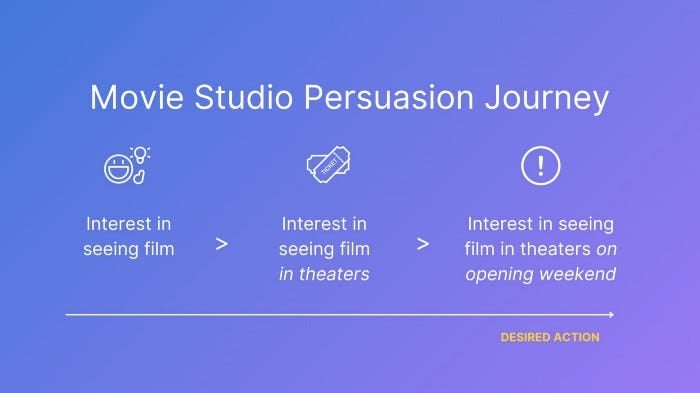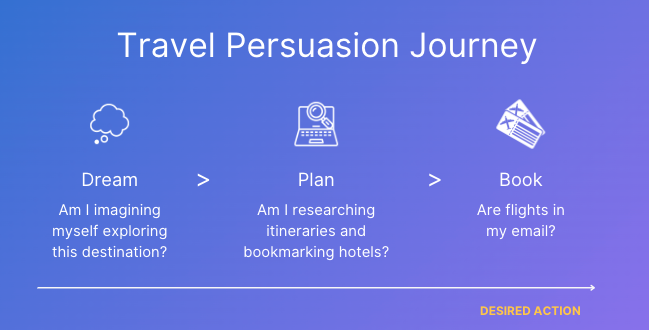Forget Customer Journeys. Here's How to Build a Persuasion Journey.
 By
Michelle Wiles
·
4 minute read
By
Michelle Wiles
·
4 minute read
3 steps to more persuasive ads
If marketing has one goal, it’s to persuade audiences to take action: buy a product, vote for a candidate, or book a vacation

The consumer decision journey is a popular tool used to map out what content is needed to persuade the audience to take that action. Typically it looks something like this: awareness, consideration, evaluation, conversion.
The problem is, people don’t live their lives that way. The journey for purchasing gum (see gum at the grocery checkout counter > add to cart) is very different from the journey to booking a vacation (get inspired > mention to friends > plan out dates > search for tickets…).

The typical consumer journey
Enter: the Persuasion Journey
The goal of a Persuasion Journey is similar to that of a consumer journey: map out the content needed to get your audience to take action. But instead of a corporate formula of awareness > consideration > evaluation > purchase, the steps in a Persuasion Journey are designed around how the audience actually lives their lives and gets closer to taking action desired by the marketer.
Instead of a corporate formula, a Persuasion Journey is designed around how the audience actually lives their lives.
For example, Swayable works with some of the world’s top movie studios to test optimize their movie trailers. Their ultimate goal is to get audiences to see a film in theaters. So the studio’s Persuasion Journey goes as follows: Interest in seeing film, Interest in seeing film in theaters, and Interest in seeing film in theaters on opening weekend.

Notice how the Persuasion Journey zeroes in on exactly what the movie studio marketers are looking to achieve. Awareness is left off, as films are short lived in the theater, so building awareness without interest doesn’t make a lot of sense. Instead, the movie studio marketers want to know if their trailer drives interest in the film, and specifically, interest in seeing it in the theater on opening weekend (are we getting your dollar or will the streaming service take it later on?).
In another instance, Swayable worked with the ad agency behind Visit Iceland’s award winning campaigns to drive travel to Iceland. The Persuasion Journey for Visit Iceland reflects the steps audiences go through when planning a vacation: Dream, Plan, Book.

So, how do you create a Persuasion Journey?
I spoke with Jason Toups, Swayable’s Director of Client Success on the steps his team takes with clients to develop their Persuasion Journeys.
1. Start with the end in mind: Zero in on what you ultimately want someone to ‘do’ (not feel or think)
We ask clients what they ultimately want to happen. e.g., I want them to fly to Iceland. I want them to buy a movie ticket for opening weekend. This becomes the final step of the Persuasion Journey.
2. Work backwards to map out the supporting beliefs that will lead to the ‘Do’
I ask clients what people need to believe along the way to get to the ‘do.’ For example, audiences might need to believe that visiting Iceland will be an adventure. Or that a movie will be really entertaining, and that it would be fun to see with friends. These supporting beliefs represent the steps in the journey, as each ‘belief’ is one step closer to persuasion.
Persuasion journeys are more flexible than traditional customer journeys because they’re not linear. There may be multiple beliefs for audiences to achieve before they are fully ready to take action. For example, a parent may need to believe that a movie is both good for children and entertaining for parents before buying a ticket.
3. Track the journey
Once you have your steps, set up metrics for each one. We design survey questions against each belief to measure how well a piece of content persuades audiences toward the belief:
- Step 1: Dream
- How interested are you in visiting Iceland?
- Which of the following countries are at the top of your list for your next holiday?
- Step 2: Plan
- How likely are you to research a trip to Iceland?
- How likely are you to ask a friend / family member to visit Iceland?
- Step 3: Book
- How likely are you to book a ticket to visit Iceland?
- The great thing about testing content against multiple persuasion metrics is that you can identify where in the journey you are weak, and develop new content to address those areas.
Persuasion Journeys are also a way to develop new marketing strategies.
Jason described a time he was working with a popular brand of English muffins. Their ultimate goal (the ‘Do’) was to get customers to buy the product more often in grocery stores. By building out the Persuasion Journey, the team identified a belief they needed to address: Audiences saw the product as a breakfast food only.
We needed to build the belief that English muffins are a good choice for purposes outside of breakfast: sandwiches, hors d’oeuvres, etc. — Jason Toups, Swayable’s Director of Client Success
Brands then use the Persuasion Journey to design their content, and ultimately, their content testing plans. For example, the English muffin brand could create a series of concepts to address the belief that English muffins are more than a breakfast food (e.g. party-snack recipes with English muffins, ads about renaming English muffins to Anytime muffins, packaging that features English muffin dinner recipes), and test the concepts to see which best persuades audiences towards that belief.
Any tips on how to get started?
“Try to put yourself in the customer’s shoes”, Jason advised, “and find a way to do that in an unbiased manner. Go shopping. Visit your own stores. Buy a ticket for your film. Along the way, ask yourself, ‘If I were a customer, what would I need to believe before taking this action?’
At Swayable we learned more about how our clients approach our product when we ran a test for our own company messaging than by sitting in sales calls.”
Takeaways
- Customer journeys are a tool to understand audiences, but the typical ‘awareness, consideration, conversion’ format does not reflect how consumers actually live, or nuances by category
- Marketers can use Persuasion Journeys to design content that gets audiences closer to taking action
- How? Start with the end in mind, and work backwards to map out the steps in your audience’s life (and the beliefs required to move through each one)
